Access to Technology
Computers are essential tools in all academic studies, including those in science and mathematics. It's difficult to imagine a state-of-the-art program without computer simulations, electronic databases, or interactive websites.
Recent advances in adaptive computer technology, greater reliance on computers in many fields, and increased availability and networking of electronic information have resulted in life-changing opportunities for many people with disabilities. In combination, these technologies provide people with disabilities with better access to education, careers, and other life experiences. Educators can play an important role in ensuring access to these empowering tools.
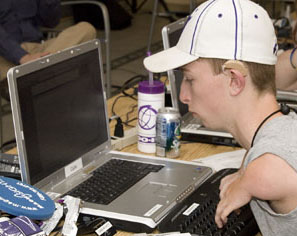
Consider a few stories of students with disabilities who are able to access information resources thanks to the availability of adaptive technology and accessible electronic resources.
- Ben cannot use his hands, but muscular dystrophy doesn't interfere with his use of the Internet; he uses a voice input program that allows him to talk his way through the Internet—six hours a day!
- Sarah uses her library's online catalog and the Internet to research and write papers for school. Her learning disability makes it difficult for her to read, so she uses a speech output system to read the screen.
- Anna is blind. She uses a screen reader and speech output system to access information on genetics. Her system works well reading text but cannot make sense of graphics.
- Shane surfs the Internet with a small tube in his mouth. The computer obeys his every command as he inputs Morse code—a sip for a dot, a puff for a dash. His cerebral palsy is only a minor inconvenience as he searches for information on his special interest, naval communication.
- Sherri is legally blind, but she has enough sight to view enlarged screen images as she uses government resources on the Internet. She is pursuing her master's degree in public administration.
- Katie is hearing impaired. She often uses a sign language interpreter. On the Internet, however, Katie communicates with her science teacher quickly and easily via email.
These stories provide examples of how access to technology enables students with disabilities to successfully pursue education and careers in STEM fields.
Access to Computer Labs
Contents of This Section
The information covered in this section can be used to help ensure that computing resources are accessible to all students. The content provides guidelines for dealing with three key issues in the school setting:
- access to computer labs
- access to computers
- access to electronic resources
As more information is delivered using computer and network technologies, school computer labs play an increasingly important role in ensuring access to electronic resources.
Background
In making electronic resources accessible, principles of universal design should be employed. Typically, organizations design their services and facilities for the average user. Universal design means planning for people with a broad range of abilities and disabilities. Keep in mind that students may have learning disabilities and visual, speech, hearing, and mobility impairments.
To plan an accessible lab, think in terms of the following access issues: physical environment, adaptive technology, and electronic resources. These areas are addressed in the video and the handout Equal Access: Universal Design of Computer Labs. The checklist in the handout can be used as a starting point for surveying a school lab for accessibility. Following the guidelines ensures that lab visitors:
- feel welcome
- are able to communicate effectively with support staff
- can get to the facility and maneuver within it
- can access printed materials and electronic resources
- can make use of equipment and software
The guidelines also ensure that staff are trained to support students with disabilities and have a plan in place to respond to specific requests in a timely manner. With these key issues in mind, you can make your lab accessible to everyone.
The following general access issues are discussed in the guidelines:
- building access
- lab staff
- physical space and printed materials
- computers and software
- electronic resources
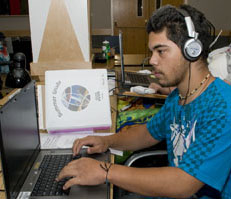
Tip: Making Computer Labs Accessible
In the Presentations section of this notebook, you will find guidelines and materials for delivering a presentation on making computer labs accessible.
First Steps
Lab managers can get started in creating an accessible lab by following these steps:
- Include students with disabilities in planning and evaluating lab products and services.
- Develop policies and procedures that ensure access to lab facilities, computers, and electronic resources for people with disabilities. Require that accessibility be considered in the procurement process.
- Ensure that the facility and services are wheelchair accessible and publications can be reached from a seated position.
- In key lab documents, include a statement about your commitment to universal access and procedures for requesting disability-related accommodations.
- Make signs with high contrast and large print.
- Make key documents available in formats accessible to those who have low vision and those who are blind (e.g., large print, Braille, electronic).
- Although a lab cannot be expected to have specialized equipment for every type of disability on hand, staff should make equipment available that they anticipate will be most often used or that is available at relatively low cost. This might include:
- an adjustable table for each type of workstation in your lab
- a wrist rest and forearm rest
- a trackball
- software to modify keyboard response such as sticky keys, repeat rate, and keystroke delay (that may be available in the operating system)
- software to enlarge screen images (that may be available in the operating system), large monitor; large-print keytop labels
- web resources that adhere to accessibility standards or guidelines adopted by the lab
- Once a lab is established and serves a large number of users, consider adding:
- text-to-speech software
- scanner and optical character recognition (OCR) software
- CCTV to enlarge printed documentation
- Braille translation software and printer
- word-prediction software
- hearing protectors
- keyboard guards to assist those who have limited fine motor skills
- alternative keyboards, mini-keyboards, or extended keyboards for users with mobility impairments
- speech input software
- one-handed keyboards or "keyboard layout" software
- Develop a procedure to ensure quick responses to requests for adaptive technology that you do not currently have available or for other disability-related accommodations.
- Train staff on available accessible products in the lab, on appropriate communication, and on procedures for addressing requests for accommodation. Include accessibility issues in all training offered in the lab.
- Include people with disabilities when addressing accessibility in periodic lab evaluations.

Achieving Career Goals: Marissa's Story
I always imagined myself in a cubicle in the office of a widely known company typing up reports, and that is exactly where I am today. Growing up using computers throughout elementary and middle school, it was natural for me to want to have a career that involved computers. There was no need for anyone to push me in that direction, though it helps that this is a field that, as my parents say, pays the "big bucks."
How I got here is an interesting story. I knew I wanted to go to college at about the same time I set my goal to graduate high school. I have cerebral palsy, and, until my senior year, I was the only person in a wheelchair at my high school. I had a circle of really good friends. We were the kind of people who got along with everyone, but we weren't all alike.
In my junior year, I began my journey with DO-IT. My geometry teacher, Cherie Smith, told me about this amazing opportunity, for which I owe her a lot. She told me the folks that make the DO-IT videos were looking for a student to feature in their next installment. I participated in the video then spoke on a DO-IT panel to inform math and science teachers about accommodations. After the panel, a DO-IT staff member approached me about joining the Summer Study Program, and I jumped at the chance. Summer Study was amazing. I got hands-on experience in college dorms and with the newest technologies. More importantly, I made lifelong friendships. DO-IT really opened me up and gave me a positive view of college life.
My disability was not really a factor in the classroom. I am just like any other person with classes I preferred and others I disliked but completed to the best of my ability. I always put schoolwork before any other after-school activities. In the computer lab I sat at an ADA station where the desk could be easily raised or lowered to accommodate my wheelchair. Although I type at an average 30+ wpm, I know I could still benefit from speech-to-text software if I took the time to look into acquiring it. I am eternally grateful for technologies like the computer. My hand would be forever aching if I didn't have access to one.
When it came time for my high school graduation in 1999, I began to consider attending college. At first, I was focused on earning my associate's degree at a community college and transferring to a four-year university. During my first year, I grew bored. I felt I wasn't getting anywhere taking the prerequisites for the Computer Information Server program. I wanted to get my hands on a computer! That summer I ended up missing the deadline for financial aid, and my summer break ended up being closer to two years.
As the two-year marker neared, my mom was urging me to return to school, and I wanted to as well. So I sought out a counselor at the Division of Vocational Rehabilitation who helped me to rethink the path I wanted to take. I realized I enjoyed working with computer applications rather than trying to fix internal computer problems. I'm so glad I took the time to figure that out or I'd be getting up everyday absolutely hating my career.
In January of 2002, I re-entered the community college world excited about the new direction I was taking. I started back to school with eight credits, but as I began to enjoy the things I was learning as each quarter progressed, I wanted to challenge myself with more until I was exceeding a full-time schedule.
After I returned to school, happy with my chosen career path, I experienced some great success. In the fall of 2003, one of my instructors approached me with the idea of applying to become a tutor for the business technology classes. I soon found myself among my peers helping them with their schoolwork. Twice I made the Vice President's list for academic achievement. I also found an internship in the offices of a performing arts center. A friend of mine told me about the internship, which gave me good practical experience and taught me the value of networking through friends and family.
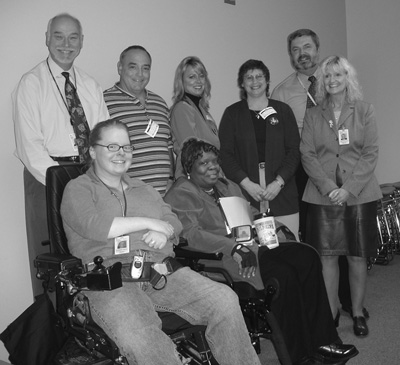
To fulfill my second internship requirement I worked with DO-IT staff and set up an internship with Amazon.com, that big-name company I had always pictured myself working for! At first I was excited to be working at the company I'd always dreamed of. But soon I realized that, although it was an excellent learning experience, it did not live up to my expectations. The job was fine, but it wasn't for me. Shortly after completing the internship at Amazon.com, in March of 2005, I graduated from community college with not just one but two degrees: business management and administrative assistance in professional technical programs.
Employment was my obvious next step. I worked hard to finish school. My degree means a lot to me and will get me somewhere in life. After graduation, I contacted DO-IT again to work on my resume and get another internship going, this time with the Federal Aviation Administration (FAA). Previously I'd never thought I'd want to work in government, but the job I was doing at FAA surprised me, and I loved it. When the internship ended they offered me a full time position, and now I work there in a permanent position with benefits! This really is what I wanted.
As I said in my introduction, I've always pictured myself sitting in a cubicle of a widely known company, happy as a clam, utilizing my newly acquired skills as an administrative assistant, possibly climbing the ladder to office manager, and that is where I am today. Staying in touch with DO-IT even after completing the Scholars program has allowed me to come to the staff for assistance in obtaining additional internships, getting help updating resumes, practicing interview skills, and ultimately securing a great job.
I have been and always will be a big yet simple dreamer. "I'm not here to conquer the world, just to be happy and comfortably living in it."
Access to Computers
Using computing resources can increase the independence, capabilities, and productivity of students with disabilities. Computers can benefit people with low vision, blindness, hearing impairments, speech impairments, specific learning disabilities, mobility impairments, and health impairments.
Background
Access to computing resources for students with disabilities involves two issues: access to the computers themselves and access to electronic resources. Electronic resources include applications and programs (e.g., word processors and spreadsheets) and information resources (e.g., online encyclopedias and databases). In this section we will look at the solutions that adaptive technology provides in enabling access to computers for people with disabilities.
View the video and read the publication Working Together: People with Disabilities and Computer Technology for an overview of computer access challenges. The video highlights some of the special advantages access to computers, adaptive technology, software, and the Internet provide to people with specific disabilities. For more information about technology access issues in the workplace view the video Access to Technology in the Workplace: In Our Own Words.
As the individuals in the videos demonstrate, computers help reduce many barriers faced by people with disabilities. There are various technologies that make it possible for people who have disabilities to use computing resources. The videos highlight several examples, since abilities, disabilities, and learning styles are unique to each person. Many accommodations are simple, creative alternatives to traditional ways of doing things. Teachers and students can generate other effective strategies.
Access challenges and solutions for students with a variety of disabilities are described in the following sections. Disability categories covered include sensory impairments, specific learning disabilities, mobility impairments, and health impairments.
Sensory Impairments
The appearance of personal computers twenty years ago heralded new education and employment opportunities for people with disabilities, including those with sensory impairments. Because sound was rarely used, people with hearing impairments experienced few limitations in operating the early personal computers. Not long after the introduction of the personal computer, software and hardware systems for reading on-screen text aloud were developed for people with visual impairments.
As computers and operating systems have become increasingly sophisticated, adapting computers for use by people with sensory impairments has posed increasing challenges. The advent of graphical interfaces (e.g., Microsoft Windows and the Apple OS) complicates computer access for people who cannot see the screen, since their speech output systems read only text. Multimedia output that uses audio is not accessible to people who cannot hear. And people who cannot feel a keyboard cannot type effectively. Fortunately, specialized hardware and software can make computer systems usable by anyone with a sensory impairment.
Types of Sensory Impairments
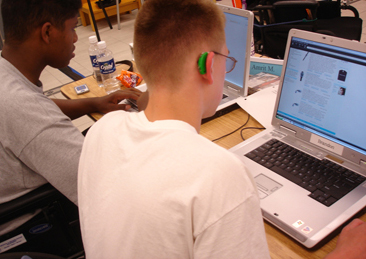
A person with a sensory impairment has a reduced ability or lack of ability in using one or more of three senses—vision, touch, and hearing. The effects of a sensory impairment can range from slight to complete loss of ability to use the sense. It may have a mild or severe impact on daily living. Sensory impairments may be present along with other disabilities such as mobility impairments or learning disabilities.
Visual impairments include low vision and blindness. Low vision is used to describe a loss of visual acuity while retaining some vision. It may be combined with light sensitivity and can vary in its effect. Some people with visual impairments have uniform vision loss. Others might have visual field limitations that result in tunnel vision or alternating areas of total blindness and vision. Some people experience loss of color vision. Blindness usually refers to a complete lack of vision; however, people who are legally blind may have some useful vision.
Hearing impairments include partial or complete hearing loss. People who are deaf have very little useful hearing ability. Those who have more functional hearing ability are referred to as hard of hearing.
Nerve damage associated with diabetes may result in peripheral neuropathy. This condition is manifested in numbness or a lack of sensitivity in limbs, including fingertips.Sometimes it is obvious that a person has a sensory impairment—for example, a person who uses a guide dog. Other disabilities are less apparent. For example, someone who is deaf or who has neuropathy may have no obvious impairment. Someone with a sensory impairment may not require any special technology, while others require significant enhancements to a standard computer in order to access all features.
It is useful for assistive technology practitioners to know about specific disabilities and how they might affect successful computer use, but it is not essential to be a disability expert. It is less important to know how a sensory impairment was acquired than it is to know what abilities a person has and what tasks they need to perform.
Although the use of assistive technology does not remove a sensory impairment, it can remediate its effects so that a person is able to use a computer with full or nearly full functionality. With appropriate computing tools and well-defined strategies for their use, the person with a sensory impairment is able to demonstrate and apply his or her knowledge.
The person with a sensory impairment should play a key role in determining his or her goals and needs in selecting adaptive technology. Once basic tools and strategies are initially selected, they can be test-driven, discarded, adapted, or refined. The end user should ultimately determine what works best. The appropriateness of specific adaptive technology for a person with a sensory limitation is usually easy to determine after a brief trial period.
View the video Working Together: Computers and People with Sensory Impairments and then read the following paragraphs for descriptions of some types of computing tools that have been used effectively by individuals with sensory impairments. The handout Working Together: Computers and People with Sensory Impairments provides further details, as well as suggested products. This list is not exhaustive; people with sensory impairments and practitioners should consider other approaches as well. New hardware and software are constantly under development and promise to continually improve access options.
Visual Impairments
The most common access approach for a computer user with a visual impairment is to enlarge the display of a monitor. This accommodation can be accomplished by using screen enlargement software. Various screen enlargement packages offer a variety of features. The most popular features enlarge the display from two to sixteen times the normal view and invert or change screen colors for those who are sensitive to the usual display of black text on a white background. Some enlargers also incorporate speech output to reduce the strain associated with reading large blocks of text.
Screen enlargement technology combined with a scanner can be used to magnify printed text. Once a page is scanned with a standard desktop scanner, the results are displayed in large print on the computer screen. Dedicated devices such as closed-circuit televisions (CCTVs), also called video magnifiers, magnify printed materials, photographs, and other objects.
People who are blind access computer output with speech or Braille output systems. Speech output is the most popular form of access. Most people who are blind use a standard keyboard as an input and navigation device, since using a mouse pointer requires accurate eye-hand coordination. Screen reader software uses predefined key combinations for review and navigation of the computer screen and is usually compatible with most standard software, including word processing, web browsing, and email.
Refreshable Braille displays are devices that echo information from the screen to a panel with Braille cells. Within the cells are pins that move up or down according to the text transmitted. Braille displays can provide very effective accommodations for users who require precise navigation and editing, such as when creating computer program code that isn't conveyed easily in speech. Some displays also provide navigation and orientation information to the computer user who is blind.
For novice screen reader users who need access to the Internet, consider dedicated web-browsing software that incorporates speech or large print. These browsers ease the process of navigating complicated websites and simplify web searching and reading online. Inaccessible web design (e.g., embedding content in graphical images without providing text alternatives) presents a significant barrier to individuals who are blind and using speech or Braille output devices.
Hearing Impairments
There are few adaptations available (or necessary) for people with hearing impairments using standard computer productivity software. Sound is used little in mainstream applications such as word processing or email, and when it is used, there is often a visual alternative. Built-in operating system features found in the control panels of software applications provide visual displays for system-generated alerts.
The increasing use of streaming media is a concern for those who cannot hear. Content developers rarely include captioning in video presentations or transcribe the audio into text.
Limited Sensitivity
Loss of sensitivity in hands or fingers due to peripheral neuropathy or other causes can make it difficult or impossible to use a standard keyboard and mouse. People with this type of sensory impairment can benefit from the use of speech-input software to control a computer and enter text. Because neuropathy may be accompanied by vision loss, use of speech output may also be required. Sometimes middleware—software that serves as a go-between for two other programs—is required for screen-reading software to work with speech output software.
Specific Learning Disabilities
A specific learning disability is in most situations a hidden disability. Because there are no outward signs of a disability, such as a white cane or a wheelchair, people with a learning disability are often neglected when adaptive computer technology is considered. However, many people with learning disabilities can benefit from mainstream and specialized hardware and software to further their academic and career goals.
View the video Working Together: Computers and People with Learning Disabilities for an overview of how computers can benefit students with specific learning disabilities.
Definitions and Terminology
A specific learning disability is unique to the individual and can appear in a variety of ways. It may be difficult to diagnose, to determine impact, and to accommodate.
Generally speaking, someone may be diagnosed with a learning disability if they are of average or above-average intelligence and there is a lack of achievement at age and ability level or a large discrepancy between achievement and intellectual ability.
An untrained observer may conclude that a person with a learning disability is lazy or just not trying hard enough. They may have a difficult time understanding the large discrepancy between reading comprehension and proficiency in verbal ability. The observer sees only the input and output, not the processing of the information. Deficiencies in the processing of information make learning and expressing ideas difficult or impossible tasks. Learning disabilities usually fall within four broad categories:
- spoken language—listening and speaking
- written language—reading, writing, and spelling
- arithmetic—calculation and concepts
- reasoning—organization and integration of ideas and thoughts
A person with a learning disability may have discrepancies in one or more of these categories. The effects of a learning disability are manifested differently for different individuals and range from mild to severe. Learning disabilities may also be present along with other disabilities such as mobility or sensory impairments. Often people with AD/HD also have learning disabilities. Specific types of learning disabilities include the following:
- Dyscalculia—A person with dyscalculia has difficulty understanding and using math concepts and symbols.
- Dysgraphia—A person with dysgraphia has a difficult time with the physical task of forming letters and words using a pen and paper and has difficulty producing legible handwriting.
- Dyslexia—A person with dyslexia has difficulty recognizing and decoding written words rapidly and automatically, making it difficult to read and spell. They often have difficulty converting letters and words presented in print into the sounds and meaning of language.
- Dyspraxia—A person with dyspraxia has difficulty with the motor planning necessary to execute purposeful, voluntary movement. A person with dyspraxia of speech or verbal dyspraxia has an impairment of speech production but language comprehension is not impacted.
- Nonverbal learning disorder—A person with a nonverbal learning disorder generally has below-average motor coordination, visual-spatial organization, and social skills with verbal skills that are average or above.
- Auditory processing disorder—A person with an auditory processing disorder intermittently experiences an inability to process verbal information
Accommodations
Assistive and adaptive technologies do not cure a specific learning disability. These tools compensate rather than remedy, allowing for a demonstration of intelligence and knowledge. Adaptive technology for the person with a learning disability is a made-to-fit implementation. Trial and error may be required to find a set of appropriate tools and techniques for a specific individual. Ideally, the person plays a key role in selecting the technology, determining what works and what does not. Once basic tools and strategies are selected, they can be test driven, discarded, adapted, or refined.
Following are descriptions of some computing tools that have been used effectively by individuals with specific learning disabilities. Further details, including product and company names, can be found in the handout Working Together: Computers and People with Learning Disabilities. This list is not exhaustive and should not limit the person with a learning disability or the adaptive technology practitioner from trying something new. Today's experimental tinkering could lead to tomorrow's commonly used tool.
Word Processors
Computer-based accommodations for dyslexia may not require specialized hardware or software. For example, a person with dyslexia can benefit from using built-in word processor features such as spelling checking, grammar checking, and adjustments to font size and color.
The use of spelling checkers can allow the person with learning difficulties to remain focused on the task of communication, rather than getting bogged down in the process of trying unsuccessfully to identify and correct spelling errors. Many word processing programs also include tools for outlining thoughts and providing alternative visual formats that may compensate for difficulty in organizing words and ideas. Additionally, color-coded text options and outline capabilities present in many word processing programs are useful tools for those with difficulty sorting and sequencing thoughts and ideas.
A word processor can also be used as a compensatory tool for a person with dysgraphia. Simply using a keyboard may be a viable alternative for an individual who has difficulty expressing his thoughts in longhand.
Reading Systems
An individual who can take in information by listening much better than by reading may benefit from using a reading system. These systems allow text on screen (document, web page, or email) to be read aloud through the computer's sound card. A scanner and optical character recognition (OCR) software add the feature of reading printed text. Hard-copy text is placed on the scanner and converted into a digital image. This image is then converted to a text file, making the characters recognizable by the computer. The computer can then read the words back with a speech synthesizer and simultaneously present the words on screen.
Reading systems include options such as highlighting a word, sentence, or paragraph in a contrasting color. The reader may elect to have only one word at a time appear on the screen to improve his or her grasp of the material. Increasing the size of the text displayed on the screen can increase reading comprehension for some people with specific learning disabilities. Changing the text or background color can also benefit some people.
Concept Mapping
Some individuals have difficulty organizing and integrating thoughts and ideas while writing. Concept mapping software allows for visual representation of ideas and concepts. These representations are presented in a physical manner and can be connected with arrows to show the relationship between ideas. These graphically represented ideas can be linked, rearranged, color-coded, and matched with a variety of icons to suit the need of the user. Concept mapping software can be used as a structure for starting and organizing such diverse writing projects as poetry, term papers, resumes, schedules, or computer programs.
Word Prediction
Spelling words correctly while typing can be a challenge for some people with dyslexia. Word prediction programs prompt the user with a list of most likely word choices based on what has been typed so far. Rather than experiencing the frustration of not remembering the spelling of a word, the user can refer to the predictive list, choose the desired word, and continue with the expression of thoughts and ideas.
Phonetic Spelling
People with dyslexia often spell phonetically, making use of word prediction or spelling checker software less useful. Software that renders phonetic spelling into correctly spelled words may be a useful tool.
Speech Recognition
Speech recognition products provide appropriate tools for individuals with a wide range of learning disabilities. Speech recognition software converts the spoken word into a machine-readable format. The user speaks into a microphone, either with pauses between words (discrete speech) or in a normal talking manner (continuous speech). The discrete product, although slower, is often the better choice for those with a learning disability, because errors can be identified as they occur. Speech recognition technology requires that the user has moderately good reading comprehension to correct the program's text output.
Organizational Software/Smart Phones
Organizing schedules and information is difficult for some people with dyslexia or a nonverbal learning disorder. They may find smart phones or other organizational software helpful because they provide centralized and portable means of organizing schedules and information. These tools can assist in keeping on task and may help provide visual alternatives to represent what work needs to be done and what has been accomplished. However, they may also put some students learners at a disadvantage by requiring yet another program and interface to learn and remember to use. Some individuals lack the attention skills to regularly check the device.
Talking Calculators
A talking calculator is an appropriate tool for a person with dyscalculia. The synthesized voice output of a talking calculator provides feedback that helps the user identify any input errors. Additionally, hearing the calculated answer can provide a check against the transposition of numbers common in reading by people with dyslexia or dyscalculia.
Low-Tech Tools
Not all assistive technology for people with learning disabilities is computer-based. Common office supplies such as sticky notes and highlighter pens provide simple means of sorting and prioritizing thoughts, ideas, and concepts. Often tools of one's own making are the most effective and comfortable accommodations for learning difficulties.
Mobility Impairments
Just as an elevator or ramp provides access to spaces when a staircase is insurmountable for someone who uses a wheelchair, specialized hardware and software, called assistive or adaptive technology, make it possible for people with mobility impairments to use computers. These tools allow a person with limited, uncontrollable, or no hand or arm movement to successfully perform in school and job settings. Adaptive technology can allow a person with a mobility impairment to use all of the capabilities of a computer.
While some mobility impairments are obvious to the observer, others are less apparent. For example, individuals with repetitive stress injuries (RSI) may have no visible impairments yet require adaptive technology in order to use a computer without experiencing pain. However, people who use wheelchairs or crutches may require no special technology to access a computer. Although it may be helpful for adaptive technology practitioners to know details about specific disabilities such as muscular dystrophy, cerebral palsy, spinal cord injury, multiple sclerosis, or RSI, it is not essential to be an expert on these conditions. People with the same medical condition, such as muscular dystrophy, may require different adaptive technology. On the other hand, an accommodation for someone with cerebral palsy may also be used by someone with RSI. Learning, sensory, and other disabilities may coexist with a mobility impairment and can create additional computer access challenges.
Although it is helpful to recognize the specific limitations of an individual, it is more important to focus on the task to be completed and how the person's abilities, perhaps assisted with technology, can be used to accomplish the goal or task. Trial and error may be required to find a set of uniquely appropriate tools and techniques. Once basic tools and strategies are identified, the end user should test-drive the technology and choose what works best. View the video Working Together: Computers and People with Mobility Impairments for an overview of how computer access can be accomplished for students with mobility impairments.
Accommodations
In the following sections are descriptions of several strategies and computing tools that have been effectively used by individuals with mobility impairments. Further details, including product and company names, can be found in the handout Working Together: Computers and People with Mobility Impairments. This list is not exhaustive; the person with a mobility impairment or the adaptive technology practitioner are encouraged to try other approaches.
Facility Access
Before a person can use a computer, they need to get within effective proximity of the workstation. Aisles, doorways, and building entrances must be wheelchair-accessible. Other resources, such as telephones, restrooms, and reference areas, should be accessible as well. Don't overlook a simple barrier such as a single step or a narrow doorway. Work with architectural accessibility experts to ensure physical accessibility.
Furniture
Proper seating and positioning are important for anyone using a computer, perhaps even more so for a person with a mobility impairment. Specialized computer technology is of little value if a person cannot physically activate these devices because of inappropriate positioning. A person for whom this is an issue should consult a specialist in seating and positioning—such as an occupational therapist—to ensure that correct posture and successful control of devices can be achieved and maintained.
Flexibility in the positioning of keyboards, computer screens, and table height is important. As is true for any large group, people with mobility impairments come in all shapes and sizes. It is important that keyboards be positioned at a comfortable height and monitors be positioned for easy viewing. An adjustable table can be moved higher or lower, either manually or with a power unit, to put the monitor at the proper height. Adjustable trays can move keyboards up and down and tilt them for maximum typing efficiency. Be sure to consider simple solutions to furniture access. For example, wood blocks can raise the height of a table, and a cardboard box can be used to raise the height of a keyboard on a table.
Keyboard Access
The keyboard can be the biggest obstacle to computing for a person with a mobility impairment. Fortunately, those who lack the dexterity or range of motion necessary to operate a standard keyboard have a wide range of options from which to choose. Pointers can be held in the mouth or mounted on a hat or headgear and used to press keys on a standard keyboard. Repositioning the keyboard on the floor can allow someone to use his or her feet for typing.
Before purchasing a complex keyboard option, evaluate the accessibility features that are built into current popular operating systems. For instance, the accessibility options control panel in Microsoft Windows contains a variety of settings that can make a standard keyboard easier to use. For a person who has a single point of entry (a single finger or mouth-stick), use of StickyKeys allows keystrokes that are usually entered simultaneously to be entered sequentially. FilterKeys can eliminate repeated keystrokes for a person who tends to keep a key pressed down too long. Check the settings for these features and experiment with different time delays for optimum effect. The Apple operating systems have similar features.
Consider using the features common in popular word processors to ease text entry. For example, the AutoCorrect feature of Microsoft Word allows sentences or blocks of text, such as an address, to be represented by unique and brief letter sequences. Entering "myaddr" could be set to automatically display one's address in proper format. Long words can be abbreviated and entered into the AutoCorrect settings to increase typing speed and accuracy.
A keyguard is a plastic or metal shield that fits over a standard keyboard. Holes are drilled into the guard to help an individual with poor dexterity or hand control press only the desired key without inadvertently pressing other keys.
Alternative keyboards can be considered for a person who cannot effectively operate a regular keyboard despite changing settings or use of a keyguard. For people who have limited range of motion, a mini-keyboard may be considered. If a person has good range of motion and poor dexterity, a keyboard with extra-large keys (e.g., IntelliKeys) can offer a good solution. Several vendors offer an array of alternative keyboards, including those that are configured to relieve the effects of RSI.
When physically activating a keyboard by either changing the operating system settings or switching to an alternative keyboard is not possible, evaluate the utility of a virtual keyboard. A virtual keyboard appears on the computer screen as a picture of a keyboard. A mouse, trackball, or alternative pointing system activates the keys on the screen and inserts the appropriate keystrokes into the desired program. A person can enter text by clicking on specific keys on the keyboard image. Modifier keys, such as CONTROL and ALT, can also be accessed, as can the function keys. Some virtual keyboards incorporate word prediction (see below) to increase entry speed and may include alternate layouts in addition to the traditional QWERTY layout found on standard keyboards.
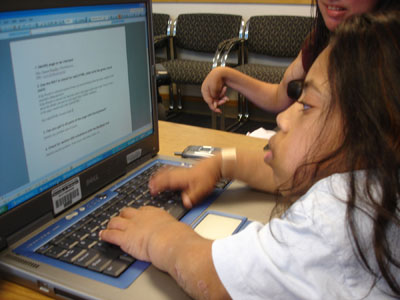
Word Prediction
Typing words correctly and quickly can be a challenge for some people with mobility impairments. Word prediction programs prompt the user with a list of likely word choices based on words previously typed. Word prediction is often used with a virtual keyboard to increase accuracy and typing speed. For those who type much faster than 13–15 words per minute, use of word prediction can actually decrease typing speed because of the time it takes the user to select a word.
Alternative Pointing Systems
With graphically oriented operating systems, it is vital to have access to a mouse or an alternative pointing device. For those who lack the dexterity or coordination to use a standard mouse, there are many alternatives to consider. Trackballs are a good first choice; the control surface can be easier to manipulate, and the buttons can be activated without affecting the pointer position. Some trackballs offer additional buttons that add functionality, such as double clicking, click and hold, and other commands, and can be programmed to a person's specific needs. A simple accommodation for use of a pointer by someone who can't use her hands but can move her feet is to place a standard mouse or trackball on the floor.
Other alternative pointers can be found in many mainstream computer stores and supply catalogs. External touchpads, similar to those built into many laptops, offer ideal pointing systems for some. A handheld pointing device with a small control surface area may be useful for someone with very limited hand mobility.
A person with good head control who cannot operate a mouse or alternative pointing device with any limb should consider using a head-controlled pointing system. These pointing systems use infrared detection and a transmitter or reflector that is worn on the user's head and translates head movements into mouse pointer movement on the computer screen. Use of an additional switch (see below) replaces the mouse button. Combining a head-controlled pointing system with an on-screen keyboard allows full computer control for someone who cannot use a standard keyboard and mouse.
Switch Keyboard and Mouse Access Using Scanning or Morse Code
When a person cannot use a standard keyboard or mouse, using a switch may be a possibility. Switches come in a nearly limitless array and can be controlled with nearly any body part. Switches can be activated with a kick, a swipe of the hand, sip and puff by mouth, head movement, an eyeblink, or touch. Even physical closeness can activate a proximity switch. These switches work in concert with a box or emulator that sends commands from the keyboard or mouse to the computer. Although switch input may be slow, it allows for independent computer use for some people who could not otherwise access a computer.
There are a variety of input methods that rely on switches. Scanning and Morse code are two of the most popular. Upon activation of a switch, scanning will bring up a main menu of options on the screen.
Additional switch activations allow a drilling down of menu items to the desired keystroke, mouse, or menu action. Morse code is a more direct method of control than scanning and with practice can be a very efficient input method. Most learners quickly adapt to using Morse code and can achieve high entry speeds.
Switch systems should be mounted with the assistance of a knowledgeable professional, such as an occupational therapist. It is important that switch mounting on a wheelchair does not interfere with wheelchair controls. Seating and positioning specialists can also help determine optimum placement for switches, reduce the time required for discovering the best switch system, and maximize positive outcomes.
Speech Recognition
Speech recognition products provide an input tool for individuals with a wide range of disabilities. Speech recognition software converts words spoken into a microphone into machine-readable format. The user speaks into the microphone either with pauses between words (discrete speech) or in a normal talking manner (continuous speech). The discrete speech system, although slower, allows the user to identify errors as they occur. In continuous speech systems, corrections are made after the fact. Speech recognition technology requires that the user have moderately good reading comprehension in order to correct the program's text output. Voice and breath stamina should also be a consideration when speech recognition is evaluated as an input option.
Reading Systems
An individual who has a difficult time holding printed material or turning pages may benefit from a reading system. These systems are typically made up of hardware (scanner, computer, monitor, and sound card), optical character recognition (OCR) software, and a reading program. Hard-copy text is placed on the scanner, where it is converted into a digital image. The image is then converted to a text file, making the characters recognizable by the computer. The computer can then read the words back with a speech synthesizer and simultaneously present the words on screen. Use of such a system may require assistance, since a disability that limits manipulation of a book may also preclude independent use of a scanner.
Low-Tech Tools
Not all assistive technology for people with mobility impairments is computer-based. The use of common items, such as adhesive velcro to mount switches or power controls, can provide simple solutions to computer access barriers. Often, tools of one's own making provide the most effective and comfortable accommodations for mobility impairments.
Health Impairments
Some health conditions and medications affect memory or energy levels. Additionally, some students who have health impairments may not be able to visit the lab facility because of conditions that limit their exposure to traditional forms of instruction. Providing class information or course content online and facilitating email correspondence can benefit students who access the Internet from their homes or the hospital.
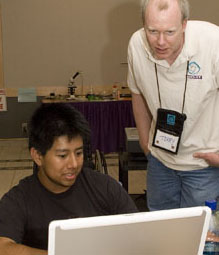
Tip: Access to Computers
In the Presentations section of this notebook, you will find guidelines and materials for delivering a presentation on access to computers.
Planning for Assistive Technology
Computer and network technologies can play a key role in increasing the independence, productivity, and participation of students with disabilities in academic programs and careers. Adaptive technology comes in many forms with many different characteristics. It comes as hardware, software, or a combination of the two. Some is easy to install, and some requires long-range planning, analysis of needs and options, and funding for implementation. For example, a trackball is inexpensive and can be easily added to a workstation for assisting people who have difficulty using a standard mouse. On the other hand, text-to-speech software combined with a speaker, a scanner, Braille translation software, and a Braille printer require a significant financial investment, technical expertise, and long-term planning. Adaptive software solutions, such as screen enlargement programs, can be installed on one machine or networked so that they are available from more than one computer workstation.
Adaptive technology can be easy to use or difficult to learn, requiring a great deal of commitment on the part of the individual user. For example, an expanded keyboard plugs into a standard keyboard holder on the computer and operates like a regular keyboard, whereas a speech input system requires training to use: each user must train the system to recognize his or her voice.
Adaptive technology can be generic or unique to the individual. For example, screen enlargement software serves people with a variety of levels of visual and learning impairments; a head-controlled system is more specialized.
Given these characteristics of adaptive technology, educators should consider multiple approaches to providing accessible technology. For example, at a workstation in a computer lab, it is desirable to provide options that address the needs of a variety of students. It is best if students who use assistive technology can work side by side with their nondisabled peers. There should also be procedures in place to deal in a timely manner with specific needs that these general solutions cannot address. Lab staff can start small and add to their collection of adaptive technology as they receive requests and as they gain skills in providing training and services for them. Some of the adaptive technology they might want to purchase initially includes the following.
- Having at least one adjustable table for each type of electronic resource provides access to students who use wheelchairs or are short in stature.
- Large-print key labels assist students with low vision.
- Software to enlarge screen images provides access for students with low vision and learning disabilities.
- Large monitors of at least seventeen inches assist students with low vision and learning disabilities.
- A speech output system can be used by students with low vision, blindness, and learning disabilities.
- Trackballs provide an alternative for those who have difficulty controlling a mouse.
- Wrist and forearm rests assist many students.
Access to Electronic Resources
Development of sophisticated online multimedia resources has extended the reach of computers. Increasingly, however, these resources are not fully accessible to people with some types of disabilities. For example, screen reader software with a speech synthesizer used by a student who is blind cannot interpret graphics or video clips.
Background
The Americans with Disabilities Act (ADA) of 1990 requires that U.S. programs and services be accessible to individuals with disabilities. A 1996 Department of Justice ruling (www.usdoj.gov/crt/foia/cltr204.txt) makes it clear that ADA accessibility requirements apply to online resources.
Some students with visual impairments cannot see graphics, and some students who are deaf cannot hear audio. Some have difficulty when screens are unorganized, inconsistent, and cluttered and when descriptions and instructions are unclear. These difficulties may occur for students who have learning disabilities, speak English as a second language, or are poor readers. Other students use older equipment or slow connections or modems that limit their access to multimedia features.
As more information is delivered electronically, schools play an increasingly important role in ensuring access to online resources for all students. When evaluating the accessibility of a school's electronic resources, consider tutorials, application software, databases, and full-text resources.
Electronic resources such as school and district web pages, online catalogs, and local digital library projects, should be developed with universal access as a goal. Accessibility guidelines should be incorporated into web development standards.
Consider accessibility when purchasing new electronic resources for the school. Ask the vendor if the product has been tested for accessibility and, specifically, if the product is compatible with screen reading software. Develop a policy that electronic products in your school be reviewed for accessibility before purchase. Make it a priority to buy and develop accessible resources. Then, as a backup, be prepared to assist students to access electronic resources that they cannot access independently.
Universal Design Principles
In developing accessible electronic resources, principles of universal design (UD) should be employed. This approach will help ensure that all students will be able to independently utilize your electronic resources, regardless of their disabilities or the limitations of their equipment and software.
Typically, organizations design their electronic services for the average user. UD means that they are designed for people with a broad range of abilities and disabilities. The National Center on Universal Design has defined UD as "the design of products and environments to be usable by all people, to the greatest extent possible, without the need for adaptation or specialized design" (www.design.ncsu.edu/cud/about_ud/about_ud.htm).
Universal design principles can be applied to both facilities and tools. They are especially appropriate to consider when designing electronic resources, including online catalogs, software, and web resources. Adapted from a listing by the Center for Universal Design (CUD) at North Carolina State University, here are some general guidelines to consider in designing an electronic resource.
- Equitable use. The design is useful and marketable to people with diverse abilities. Example: A professor's website is designed so that it is accessible to everyone, including students who are blind and using text-to-speech software.
- Flexibility in use. The design accommodates a wide range of individual preferences and abilities. Example: A museum, visited as a field trip for a course, allows each student to choose to read or listen to a description of the contents of display cases.
- Simple and intuitive use. Use of the design is easy to understand, regardless of the user's experience, knowledge, language skills, or current concentration level. Example: Control buttons on science equipment are labeled with text and symbols that are simple and intuitive to understand.
- Perceptible information. The design communicates necessary information effectively to the user, regardless of ambient conditions or the user's sensory abilities. Example: A video presentation projected in a course includes captions.
- Tolerance for error. The design minimizes hazards and the adverse consequences of accidental or unintended actions. Example: Educational software provides guidance and background information when the student makes an inappropriate response.
- Low physical effort. The design can be used efficiently, comfortably, and with a minimum of fatigue. Example: Doors to a lecture hall open automatically for people with a wide variety of physical characteristics.
- Size and space for approach and use. Appropriate size and space is provided for approach, reach, manipulation, and use regardless of the user's body size, posture, or mobility. Example: A flexible science lab work area has adequate workspace for students who are left- or right-handed and for those who need to work from a standing or seated position.
Accessibility Guidelines
The World Wide Web Consortium (W3C) develops and maintains the protocols used on the web to insure interoperability to promote universal access. W3C's Web Accessibility Initiative (WAI) has proposed guidelines for all web authors. As Tim Berners-Lee, director of W3C, puts it, "The power of the web is in its universality. Access by everyone regardless of disability is an essential aspect" (www.w3.org/WAI).
In 2001, as a response to Section 508 of the Rehabilitation Act, the U.S. Architectural and Transportation Barriers Compliance Board (Access Board) developed accessibility standards for information technology developed, procured, or used by federal agencies. The list of guidelines for accessibility provides a good model even for organizations that are not required to comply.
In most school districts, many people develop web content. Building web content that is consistent, accessible, and usable can be a challenge. To ensure school-wide development of accessible web pages, consider adopting standards or guidelines that are useful and well explained. This may be as complex as constructing a set of guidelines from scratch or as simple as adopting the Section 508 web accessibility standards. Disseminate information about the standards to all web developers in the district, and provide resources, training, and technical support on an ongoing basis.
Accessible Web Design
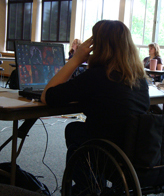
In this section, we'll apply universal design principles to a common activity in schools today: designing web pages. The Internet provides a huge network of educational, governmental, and commercial resources to all people. Most schools maintain their own websites. Yet because of the multimedia nature of the medium, some users cannot access some materials available on the web.
View the video, World Wide Access: Accessible Web Design, in which students with disabilities and practitioners share access problems and solutions. Examples of design features for making web pages accessible are described. These recommendations are covered in the handout World Wide Access: Accessible Web Design. Read this publication for more accessible design examples. If you have not created a web page before, you may be confused by some of the technical jargon used in the video and handout. If so, don't be discouraged. Focus on the basic principles, and pass the information on to staff, students, and administrators responsible for web page development at your school.
In the next few paragraphs we'll provide a few simple examples of accessible web design. An important principle to remember is to maintain a simple, consistent page layout throughout your site. Much of the power and appeal of the web comes from the fact that it presents information in a variety of formats while also organizing that information through hypertext links. Designing a well-organized site with a consistent design makes it easier for visitors to find the information they need. In particular, it benefits people with learning disabilities and attention deficits who have difficulty following disorganized presentations.
Think about the physical effort needed to use your site. Remember that small buttons marking links can be difficult targets for visitors with mobility impairments that result in restricted hand movements. Larger buttons make it easier for all visitors to select the links on your page. Along with a consistent page layout, it is important to keep backgrounds simple and make sure there is enough contrast.
Many background images and colors obscure text and make reading difficult. Make sure that there is enough contrast between your text and the background of the page. Choose background, text, and link colors carefully, and always test your site with a variety of browsers and monitors. Following this guideline will aid visitors with low vision, color blindness, and those with learning disabilities who can find busy backgrounds and moving features from page to page confusing.
Visitors who use screen-reading software with speech output can adjust their software to read only the links on a page. For this reason, links should provide enough information when read out of context. For example, never use "Click here" as a link or next to a graphic used as a link. Make links descriptive enough that they are understood out of context.
HyperText Markup Language (HTML) is the standardized code used to create websites. The code works with tags that tell a web browser where to find and how to display your information. HTML was designed to be a universal format outside the bounds of proprietary software and computer languages. The W3C specifies what is standard HTML, with the intent of maintaining a language compatible with many platforms and browsers.
The universal format of the Internet meets the equitable and flexible principles of universal design. However, many people like to use new and nonstandard features on their web pages. Such actions obstruct the original purpose of a worldwide standard and the open communication that it allows and encourages.
Using standard HTML tags will ensure that your content can be accessed by all browsers used by visitors to your site. Avoid tags such as
Notify site visitors that you are concerned about accessibility by including a statement about accessibility on your page. Encourage site visitors to notify you with their accessibility concerns. For example, the DO-IT home page includes this statement:
The DO-IT pages form a living document and are regularly updated.We strive to make them universally accessible. We minimize the use of graphics and photos, and provide descriptions of them when they are included. Video clips are open-captioned, providing access to users who can't hear the audio. Suggestions for increasing the accessibility of these pages are welcome.
People who are blind cannot view the graphical features of your website. Many people with visual impairments use voice output programs with text-based browsers or graphical browsers with the feature that loads images turned off. Include text alternatives to make the content in these graphical features accessible. This practice addresses the universal design strategy to provide redundant information in different modes of presentation.
Some people have advocated the use of alternative text versions of websites that are graphic-intensive. However, this approach adds a great deal of maintenance time and complexity, since two versions must be updated. The maintenance time increases exponentially for organizations that provide their sites in multiple language versions. Therefore, it is best to make every effort to create the original version in an accessible format. Remember, that an important principle of universal design is equitable use, so avoid segregating users of your electronic resources by their ability, the connection speed, or the type of hardware and software they use.
Get started by including short, descriptive "alt" attributes for graphical features on your page. An alt attribute is an HTML parameter used with the element to provide a text alternative to graphical content. With alternate text, users who can't see the graphics (e.g., screen reader users, text browser users, sighted users with images turned off) can still access the content.
For example, when a sighted visitor views the DO-IT home page at https://www.washington.edu/doit/ with a graphical browser, they will see the DO-IT logo. When a user who is blind visits, the computer's voice output program will read "DO-IT logo" because DO-IT staff used this text as an alt attribute for the graphic. This gives the user a clear idea of what is on the page. Any visitor coming to the site using a text-based browser will understand that there is a logo there instead of the more ambiguous "image" that is the default result when no alt attribute is used.
This example can also be used to explain the difference between text and words embedded in a graphic. Web designers sometimes embed text in graphics so that they can incorporate color, fancy fonts, and other design elements into the display. It is important to differentiate between text, which screen readers can access, and words that are images, which screen readers cannot read. In the DO-IT logo, "DO-IT" is an image. DO-IT staff include "DO-IT" in the alt attribute so that the DO-IT name is displayed by a text browser and read by a speech synthesizer.
A related accessible design rule is to use menu alternatives for image maps to ensure that the embedded links are accessible. An image map is a picture on which areas can be clicked to find a link to another page. For example, a site with information on state trivia presents a map of the United States. When using a graphical browser such as Internet Explorer, a visitor can choose information by clicking on a state image. However, if the web page developer has not included an alternative text-based menu, visitors using text-based browsers may only be able to read or hear this:
States Trivia
[ismap]
At this point the visitor is stuck, since text-based browsers will not interpret the hypertext links embedded in the image map. Accessibility of image maps may involve providing attributes for every hyperlink in an image map or navigation menu, or a listing of hypertext links above or below the image map.
Including alt attributes is sufficient for logos and graphics that are not critical to the information content of the page. But if the graphics provide information beyond this, adding captions and transcriptions is important for those who cannot see your page because they are using a text-based browser, possibly because they are blind. Include descriptive captions for photographs and pictures. Provide enough detail so that a visitor who cannot see the pictures will understand the content that the images add to the page. If you present information embedded in an image format (e.g., PDF), such as a scanned-in image of a page of a manuscript, be sure to also include a transcription of the manuscript in a text format. This practice benefits many visitors, including those with visual impairments, users who speak English as a second language, and those with learning disabilities. Again, think redundancy.
Multimedia and audio formats can present barriers to people with hearing impairments and to people with less sophisticated computer systems. Provide captions and/or transcriptions for spoken materials so these visitors have an alternative method of accessing this information.
New accessibility issues have emerged as the web is changing from static pages to a dynamic, interactive social space. For example, Flash applications are inaccessible to individuals who are blind and using screen reader and speech output technology. It is wise for web designers to use Flash when specific features such as animation are desired, avoid using it for navigation features, and provide alternatives for important content presented with Flash.
Consult the AccessWeb website for links to resources on accessible web design.
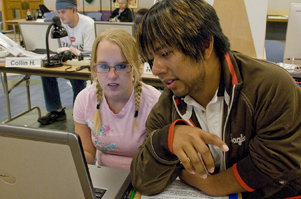
Web Page Tests
Test your web pages with as many web browsers as you can. Always use at least one text-based browser. This way, you will see your web resources from the many perspectives of your users.
Part of testing your website includes running it against an HTML validator program. These programs compare the HTML at your site with the rules of standard HTML. They generate a report listing errors and nonstandard tags. Some validators check specifically for accessibility. Try using an accessibility validation site, which performs a diagnostic on your pages and points out parts that could be inaccessible.
Teaching Students About Accessible Web Design
If you are teaching a course on web design or assigning to students the development of web pages in another course, consider requiring that students produce accessible products. Consult the publication Universal Design of Web Pages in Class Projects for ideas about how to incorporate accessible web design into your curriculum.
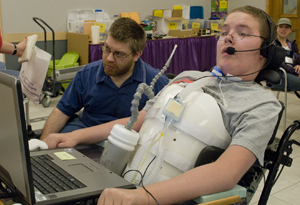
Tip: Access to Electronic Resources
In the Presentations section of this notebook, you will find guidelines and materials for delivering a presentation on access to electronic resources.
Whether you are developing electronic resources or designing a lab for your school, apply universal design principles to maximize access. In particular, consider these accessible web design principles when developing web pages.
- Maintain a simple, consistent page layout.
- Keep backgrounds simple. Make sure there is enough contrast.
- Use standard HTML.
- Include a note about accessibility.
- Provide text alternatives (alt attributes, captions, alternative menus, transcriptions) for graphical features.
- Use special features with care.
- Test your web pages with a variety of browsers.
Schools have a moral and legal responsibility to make computing resources accessible to students and community members with disabilities. They must provide accessible buildings, computers, and electronic resources. You should also demand from vendors that the products you purchase employ access features. Administrators can access further instruction for adopting and implementing web accessibility policies and procedures in their schools by consulting the publication Web Accessibility: Guidelines for Administrators.
Putting It All Together
When facilities are accessible, assistive technology is provided, and electronic resources are universally designed, all students can participate in technology-based instruction. A computer camp provides a good example of how all of this can come together. View the video Camp: Beyond Summer and read the publication Beyond Summer: Conducting Internet Activities at Camp.
It is clear that positive outcomes can be experienced by students with disabilities who have access to facilities, computers, and electronic resources. A typical camp for children and youth might want to add Internet activities to its program offerings for many reasons.
- Learning to use the Internet is fun and fits in with the exploratory nature of camps.
- Internet work can support interaction for socializing, support, and program participation year-round for those campers who gain Internet access in their homes or schools.
- Internet activities can support academic growth as campers use technology, practice reading and writing, and access information.
In short, with growing concern over the low academic achievements of American youth, summer camping programs can be part of the solution while providing new, exciting experiences for their campers. However, efforts should be made by any camp program to ensure that computing facilities are accessible, students with disabilities have access to the assistive technology they need, and that the electronic resources used are designed to be accessible to all participants. Only then can technology truly level the playing field for all participants.

Tip: Instruction in Technology Access
In delivering technology instruction to preservice and inservice teachers, be sure to emphasize the three important access issues for school and other programs, such as summer camps, to address—access to the facility, access to the computer, and access to the electronic resources. Universal design applied in all three areas leads to an accessible technology program. In the Presentations section of this notebook, you will find guidelines and materials for delivering this content.